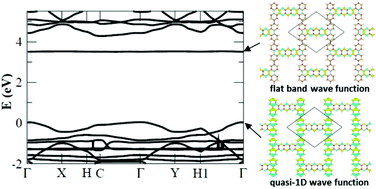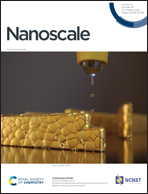Isolated flat bands and physics of mixed dimensions in a 2D covalent organic framework†
Abstract
We demonstrate that it is possible to rationally incorporate both an isolated flat band and the physics of zero dimensions (0D), one dimension (1D), and two dimensions (2D) in a single 2D material. Such unique electronic properties are present in a recently synthesized 2D covalent organic framework (COF), where “I”-shaped building blocks and “T”-shaped connectors result in quasi-1D chains that are linked by quasi-0D bridge units arranged in a stable 2D lattice. The lowest unoccupied conduction band is an isolated flat band, and electron-doping gives rise to novel quantum phenomena, such as magnetism and Mott insulating phases. The highest occupied valence band arises from wave functions in the quasi-1D chains. Examples of mixed dimensional physics are illustrated in this system. The strong electron–hole asymmetry in this material results in a large Seebeck coefficient, while the quasi-1D nature of the chains leads to linear dichroism, in conjunction with strongly bound 2D excitons. We elucidate strategies to design and optimize 2D COFs to host both isolated flat bands and quantum-confined 1D subsystems. The properties of the 2D COF discussed here provide a taste of the intriguing possibilities in this open research field.

- This article is part of the themed collection: Editor’s Choice: Thermoelectric nanostructures


 Please wait while we load your content...
Please wait while we load your content...